Country
Crash of a Douglas C-54G-15-DO Skymaster in Norman Wells
Date & Time:
Jan 5, 2006 at 1704 LT
Registration:
C-GXKN
Survivors:
Yes
Schedule:
Norman Wells – Yellowknife
MSN:
36090
YOM:
1946
Flight number:
BFL1405
Crew on board:
4
Crew fatalities:
Pax on board:
0
Pax fatalities:
Other fatalities:
Total fatalities:
0
Circumstances:
The Buffalo Airways Limited Douglas C-54G-DC (DC-4), registration C-GXKN, serial number 36090, departed from Norman Wells, Northwest Territories, at 1749 mountain standard time for a visual flight rules flight to Yellowknife, Northwest Territories, with a crew of four and 2000 pounds of cargo. While climbing through an altitude of approximately 3500 feet above sea level, the crew experienced a failure of the number 2 engine and a nacelle fire. The crew carried out the Engine Fire Checklist, which included discharging the fire bottles and feathering the number 2 propeller. The fire continued unabated. During this period, an uncommanded feathering of the number 1 propeller and an uncommanded extension of the main landing gear occurred. The crew planned for an emergency off-field landing, but during the descent to the landing area, the fuel selector was turned off as part of the Engine Securing Checklist, and the fire self-extinguished. A decision was made to return to the Norman Wells Airport where a successful two-engine landing was completed at 1804 mountain standard time. The aircraft sustained substantial fire damage, but there were no injuries to the four crew members on board.
Probable cause:
Findings as to Causes and Contributing Factors:
1. Airworthiness Directive AD 48-12-01 mandates the replacement of the potentially hazardous fuel line, but the line had not been replaced on this aircraft.
2. A fuel leak from the main fuel inlet line in the engine compartment of this cargo DC-4 caused an in-flight fire that spread into the nacelle and wing.
3. The fuel-fed fire burned for an extended period of time because turning the fuel selector off is not required as part of the primary Engine Fire Checklist.
1. Airworthiness Directive AD 48-12-01 mandates the replacement of the potentially hazardous fuel line, but the line had not been replaced on this aircraft.
2. A fuel leak from the main fuel inlet line in the engine compartment of this cargo DC-4 caused an in-flight fire that spread into the nacelle and wing.
3. The fuel-fed fire burned for an extended period of time because turning the fuel selector off is not required as part of the primary Engine Fire Checklist.
Final Report:
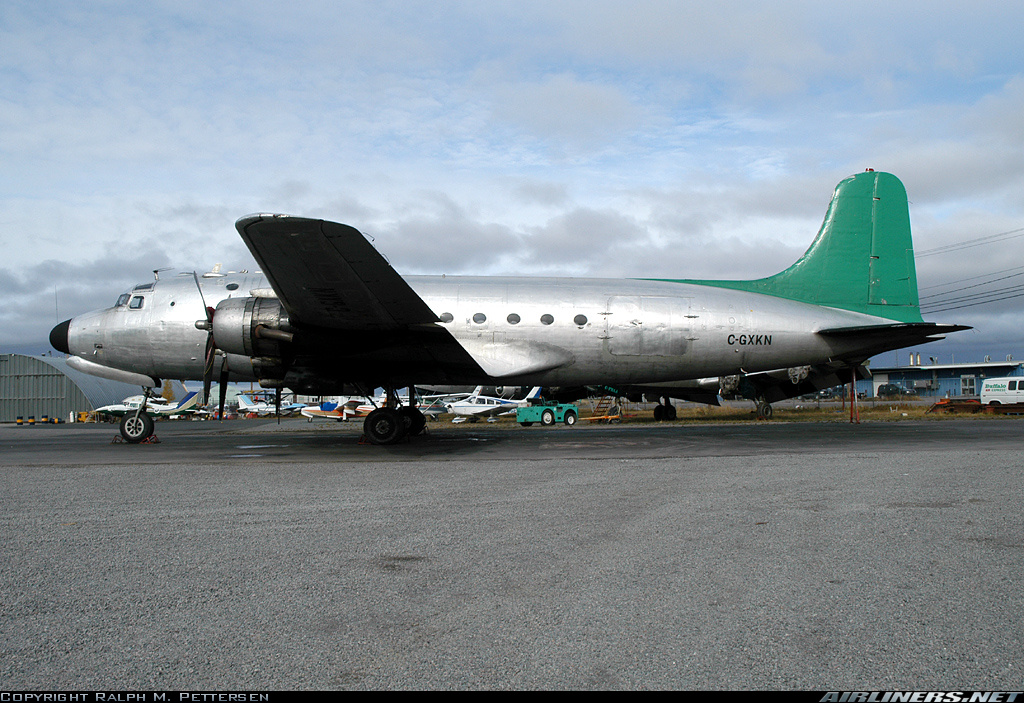
Ground explosion of a Douglas C-54B-1-DC Skymaster in Ganes Creek
Date & Time:
May 7, 2004 at 2130 LT
Registration:
N44911
Survivors:
Yes
Schedule:
Ganes Creek – Fairbanks
MSN:
10461
YOM:
1945
Crew on board:
2
Crew fatalities:
Pax on board:
0
Pax fatalities:
Other fatalities:
Total fatalities:
0
Captain / Total hours on type:
5630.00
Copilot / Total hours on type:
1560
Aircraft flight hours:
29667
Circumstances:
The crew of the 4 engine airplane started its engines for a positioning flight from a remote mining airstrip. Following the startup of the engines, an explosion occurred in the left wing area aft of the number 1 engine firewall and number 1 auxiliary fuel tank. The airplane was parked next to the mine's fuel storage tank, and the pilot added power on the remaining engines to move away from the storage tank. Within seconds of beginning to move, the number 1 engine fell off the burning wing, followed by separation and aft folding of the outboard end of the left wing. The outboard end of the wing, however, was still attached via control cables. The pilot taxied the airplane about 200 feet, dragging the partially burning left wing segment to a pond of water and shut down the remaining engines. The crew evacuated with no injuries. Water was applied to the airplane until the fire was extinguished, about 3 1/2 hours later. NTSB and FAA personnel did not travel to the scene, and the airplane was not recovered from the mining strip. The airplane's left wing powerplant and fuel system consists of the number 1 and 2 engines. Each engine is separated from the wing by a firewall. Within the wing, from outboard to inboard, the fuel tank system consists of the number 1 fuel tank, the left wing auxiliary fuel tank, and the number 2 fuel tank. Each wet-wing type fuel tank contains a submerged electrical boost pump, sump drain valves and fuel quantity transmitters. The fuel system has selector valves, crossfeed valves, and shut-off valves for each tank. An FAA inspector examined portions of the airplane that the operator supplied. The inspector examined a portion of the upper wing surface that had been blown away from the airplane during the initial explosion. He noted that the inside of the upper wing surface, normally positioned over the auxiliary tank, was not charred or sooted. A separated portion of the lower wing surface, near the auxiliary boost pump, was sooted and charred. The aft side of the number 1 engine firewall was not charred. A portion of the number 1 engine nacelle was oily, but not sooted or charred. The operator located the auxiliary in-tank boost pump and sent it to the FAA. The boost pump impeller, encased in a small wire cage, was not melted and could be turned by hand. The body of the pump was sooted but not thermally damaged. Its wire connectors and one fuel line were melted. A smaller line, what appeared to be a return line, was not melted.
Probable cause:
A fuel tank explosion in the left wing auxiliary fuel tank, and subsequent fuel fire that occurred during engine start for an undetermined reason.
Final Report:
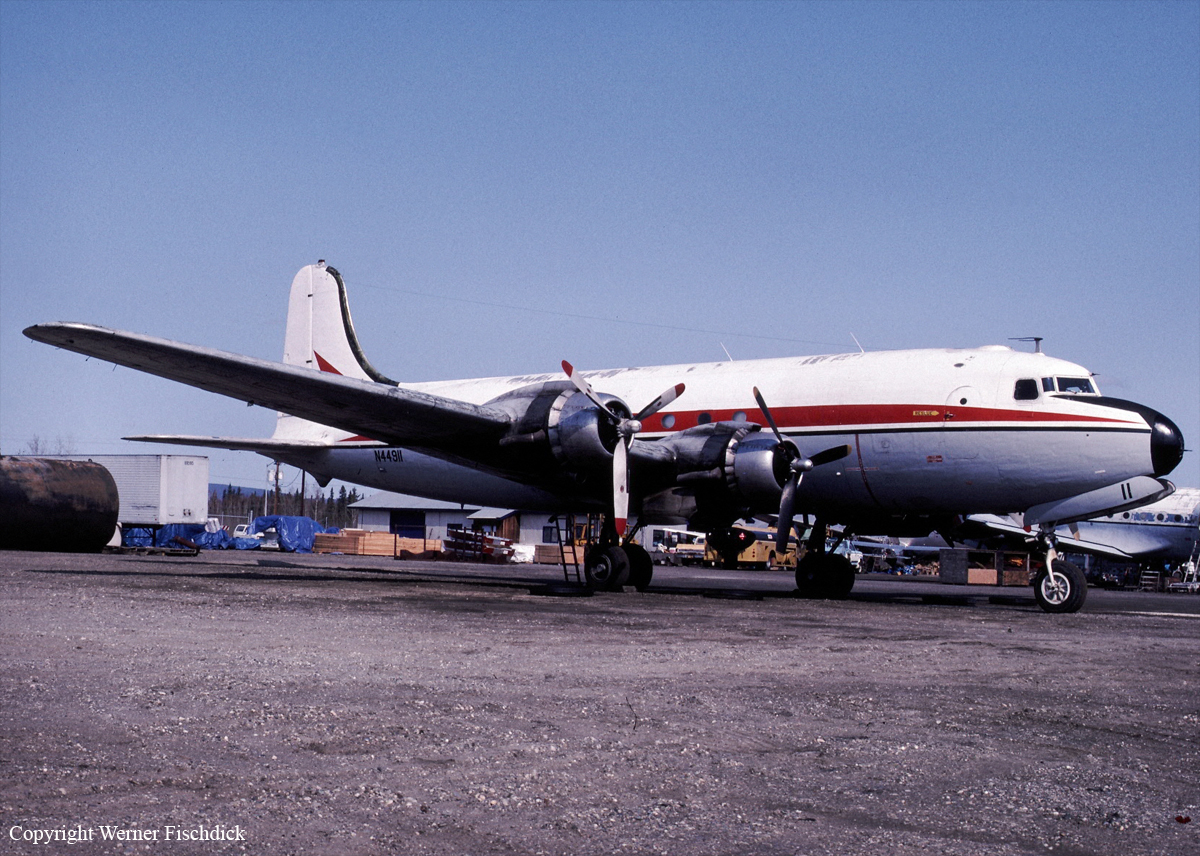
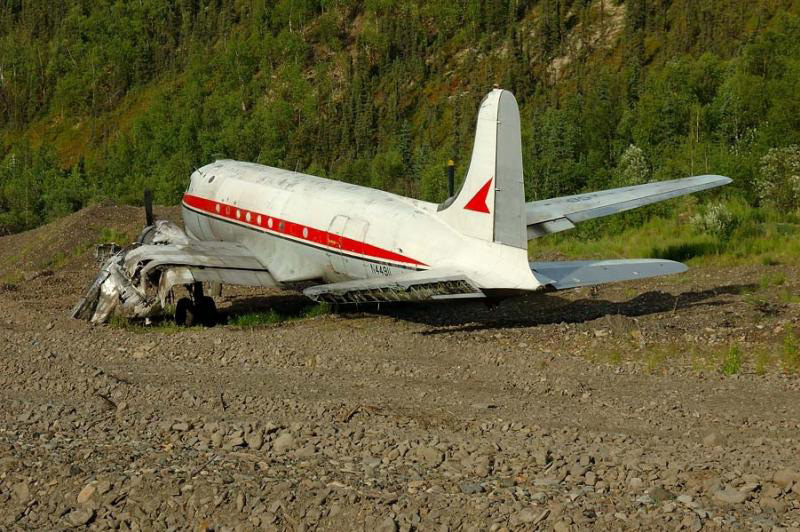
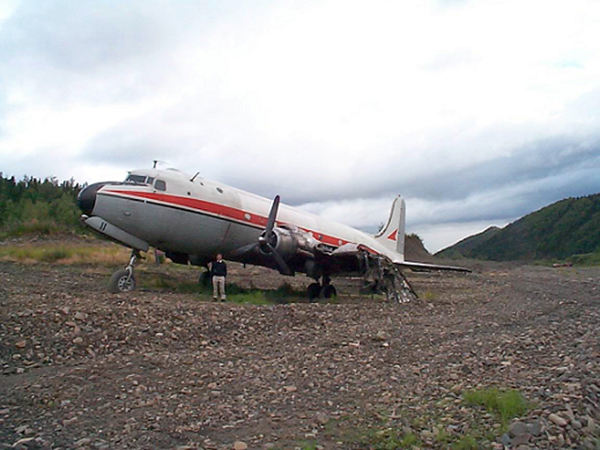
Crash of a Douglas C-54G-10-DO Skymaster in Ulu
Date & Time:
Aug 2, 2003 at 0800 LT
Registration:
C-GBSK
Survivors:
Yes
MSN:
36049
YOM:
1945
Crew on board:
2
Crew fatalities:
Pax on board:
0
Pax fatalities:
Other fatalities:
Total fatalities:
0
Circumstances:
The four engine aircraft was completing a cargo flight to Ulu, carrying four crew members and a load consisting of 45 oil drums. On final approach, the crew realized his speed was too high so he reduced engine power and selected full flaps. The aircraft lost height so power was added. But the aircraft continued to descent and struck the ground short of runway threshold. Upon impact, the undercarriage were torn off. The aircraft slid on its belly, lost its both wings and came to rest few hundred feet further. All four crew members escaped with minor injuries and the aircraft was damaged beyond repair.

Crash of a Douglas C-54E-15-DO Skymaster in Diavik
Date & Time:
Aug 28, 2002 at 1650 LT
Registration:
C-GQIC
Survivors:
Yes
Schedule:
Yellowknife – Diavik
MSN:
27343
YOM:
1944
Flight number:
BFL928
Crew on board:
2
Crew fatalities:
Pax on board:
0
Pax fatalities:
Other fatalities:
Total fatalities:
0
Circumstances:
On final approach to Diavik Airport, the four engine aircraft was too low. This caused the undercarriage to struck the ground about one metre short of runway 10 threshold. On impact, the undercarriage were torn off and the aircraft slid on the runway for almost 300 metres then lost its right wing and rotated to the right before coming to rest, bursting into flames. Both pilots escaped with minor injuries and the aircraft was destroyed.
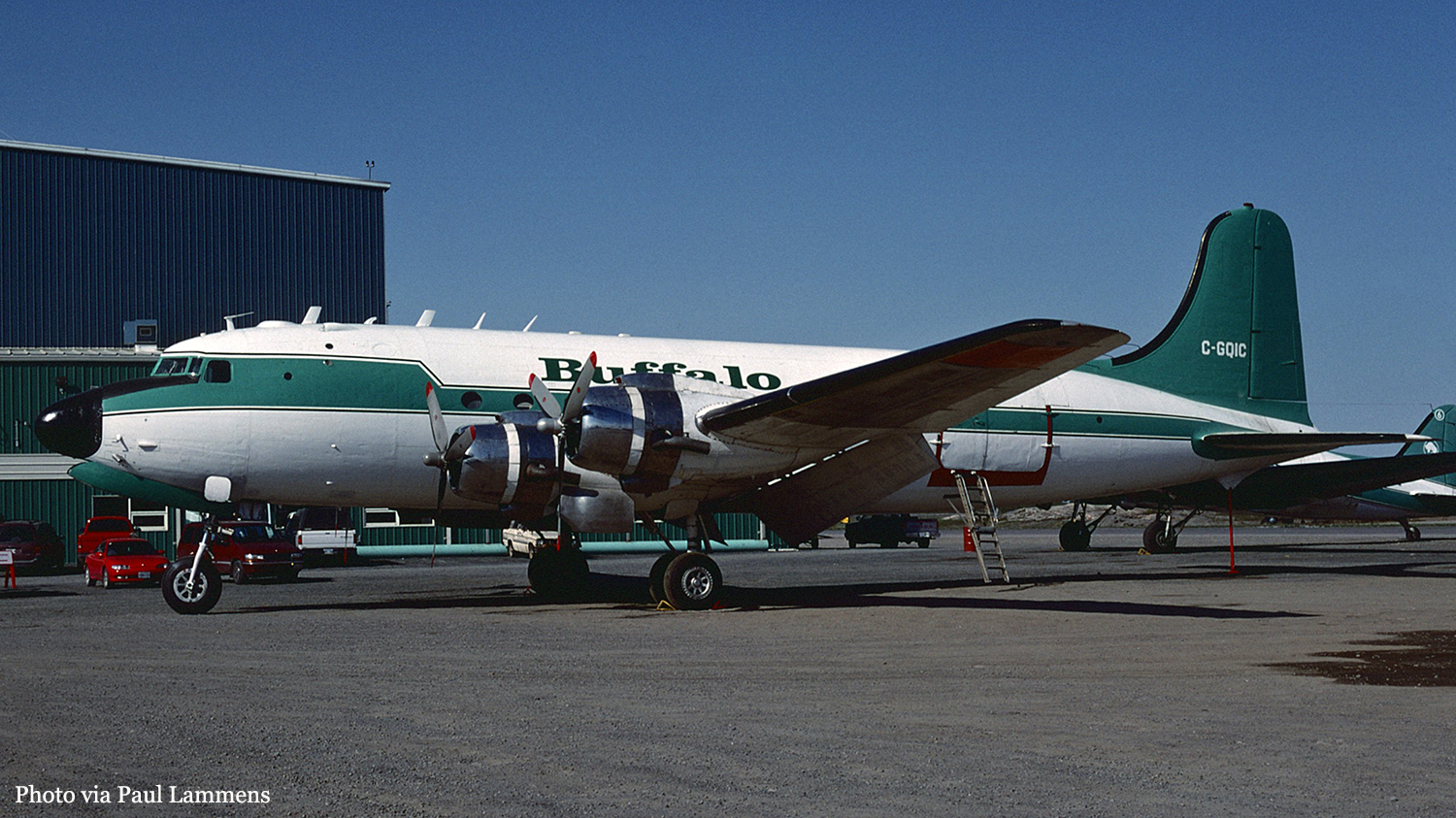

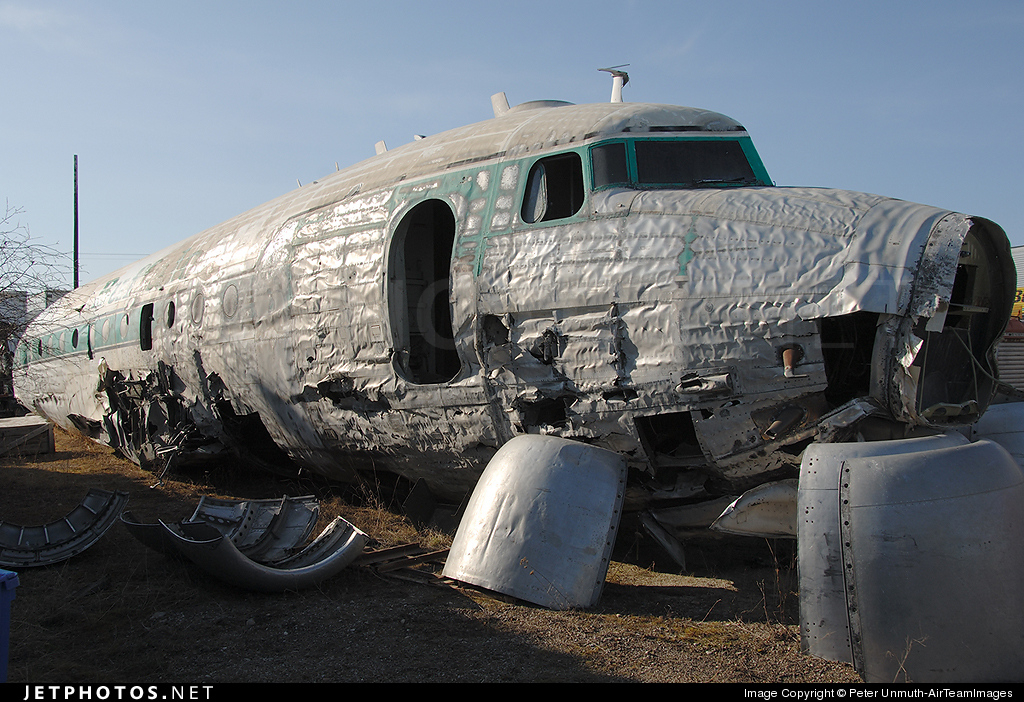
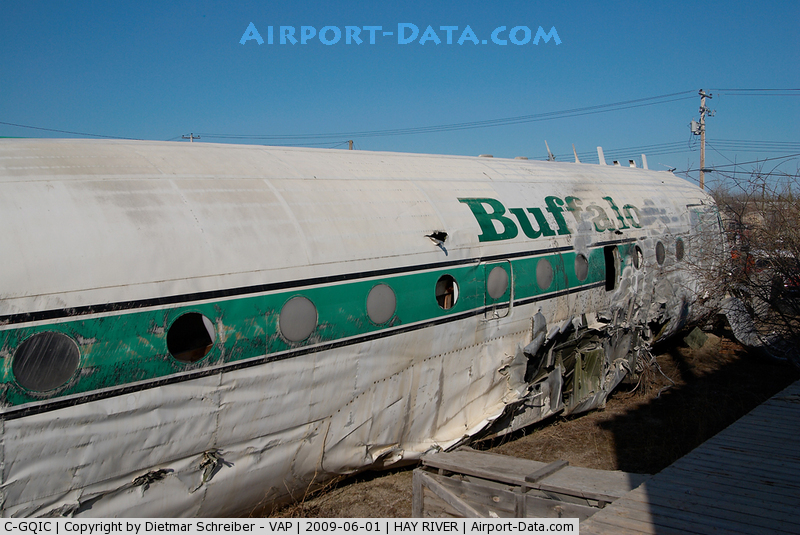

Crash of a Douglas C-54E-DO Skymaster in Bronson Creek
Date & Time:
Feb 1, 1997 at 1330 LT
Registration:
N44909
Survivors:
Yes
MSN:
27371
YOM:
1944
Crew on board:
4
Crew fatalities:
Pax on board:
0
Pax fatalities:
Other fatalities:
Total fatalities:
0
Circumstances:
After landing at Bronson Creek Airport, one of the main landing gear struck a snow wall. The aircraft went out of control and came to rest. All four crew members escaped uninjured while the aircraft was damaged beyond repair.
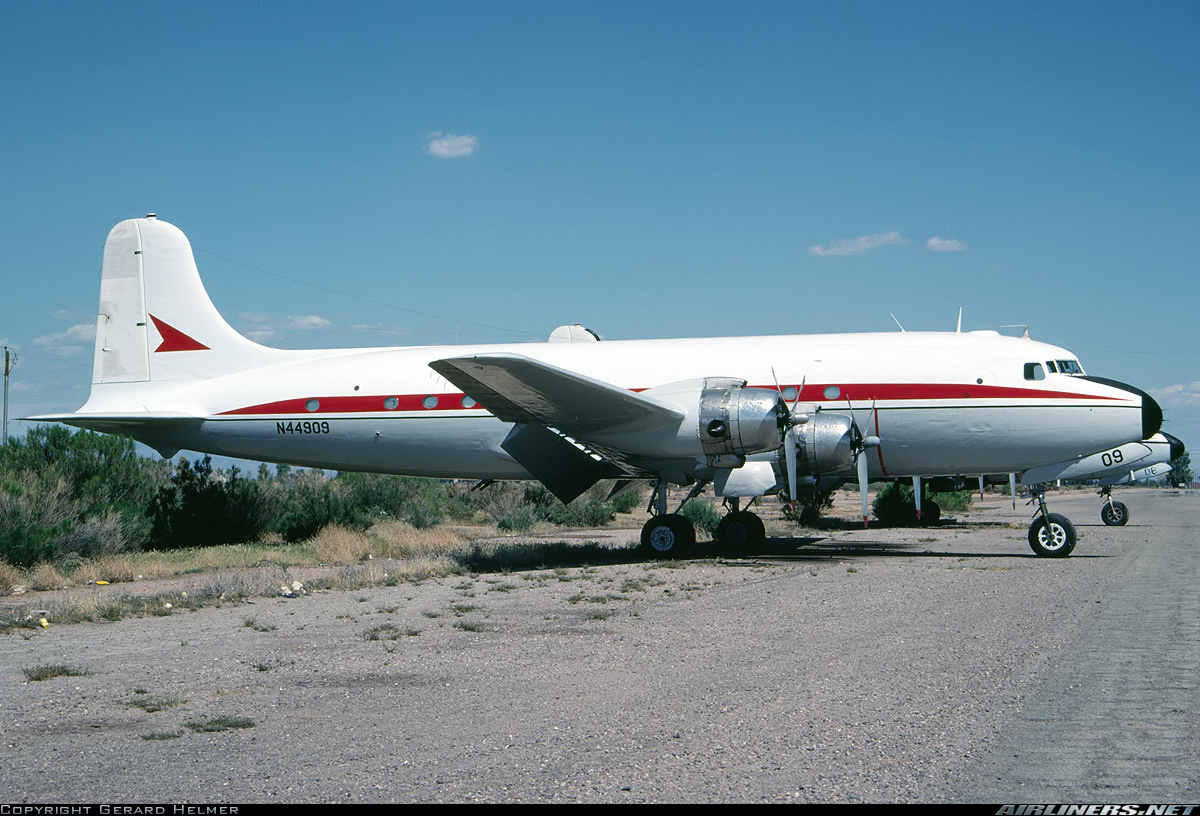
Crash of a Douglas C-54A-15-DC Skymaster near Bronson Creek: 1 killed
Date & Time:
Aug 14, 1996 at 1200 LT
Registration:
C-FGNI
Survivors:
Yes
Schedule:
Bronson Creek - Whitehorse - Wrangell
MSN:
10389
YOM:
1944
Crew on board:
3
Crew fatalities:
Pax on board:
0
Pax fatalities:
Other fatalities:
Total fatalities:
1
Captain / Total hours on type:
1500.00
Copilot / Total hours on type:
420
Aircraft flight hours:
50754
Circumstances:
The DC-4 aircraft (serial number 10389) was on a visual flight rules flight from Bronson Creek, British Columbia, to Wrangell, Alaska, with a crew of three and about 16,600 pounds of cargo on board. The departure from the remote mining strip was uneventful until the aircraft approached 1,500 feet above sea level, when the crew heard a whining noise in their headsets. Believing that the whining was caused by an inverter problem, they switched inverters, but the problem persisted. Electrical instrument indications in the cockpit then became erratic, and the number 2 engine, on the left wing, began to misfire; its fire warning light in the cockpit illuminated briefly, but without the accompanying bell. The captain confirmed visually that the number 2 engine was on fire and the crew carried out the engine fire drill; however, the fire did not extinguish. The captain commenced a right-hand turn to return to the Bronson Creek airstrip, and announced to the crew that the number 2 engine had separated from the wing. The captain applied maximum power to the three remaining engines; however, the aircraft began to lose altitude. Both pilots held the rudder and aileron controls at full right deflection in an attempt to prevent the aircraft from yawing or rolling to the left. The aircraft was shaking violently at that time, and the crew members were unable to read any of the engine or flight instruments. At about 50 feet above ground level, just short of the Iskut River, the pilots closed the throttles. The aircraft descended rapidly, and the burning left wing struck a tree just as the fuselage contacted the surface of the river. The three occupants escaped the burning aircraft, and the first officer and load master swam to safety. The captain is missing and is presumed to have drowned. The aircraft was destroyed.
Probable cause:
The n°2 engine separated from the aircraft as a result of an intense fire in the wing. The loss of the engine rendered the aircraft uncontrollable, and the pilots were forced to land in the river
Final Report:
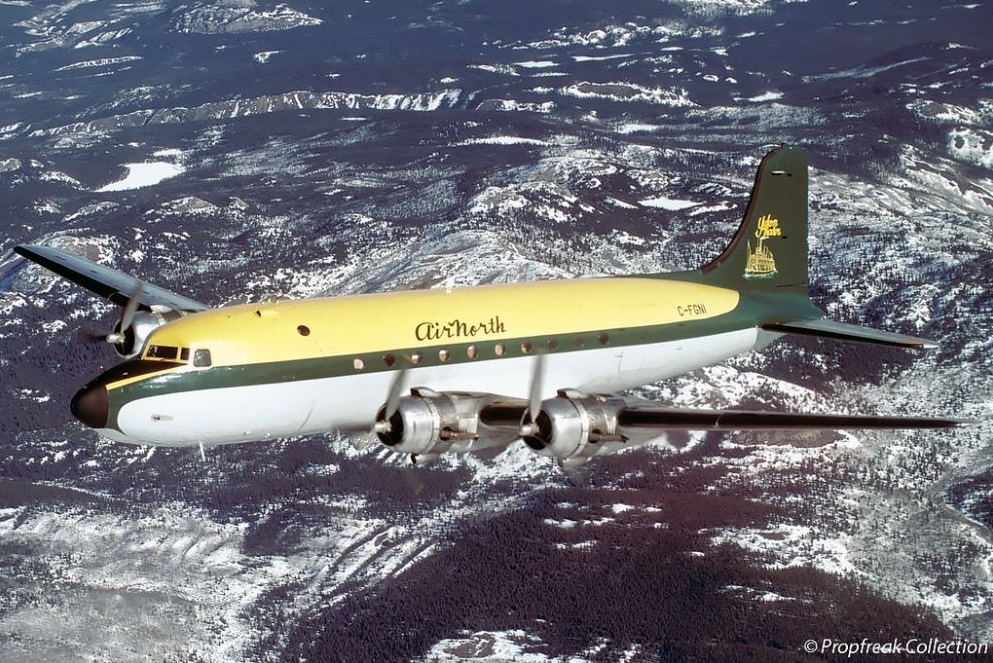
Crash of a Douglas C-54G-15-DO Skymaster in Ramona: 2 killed
Date & Time:
Jun 21, 1995 at 1108 LT
Registration:
N4989P
Survivors:
No
Schedule:
Hemet - Ramona
MSN:
36082
YOM:
1945
Flight number:
Tanker 19
Crew on board:
2
Crew fatalities:
Pax on board:
0
Pax fatalities:
Other fatalities:
Total fatalities:
2
Aircraft flight hours:
23507
Circumstances:
A Douglas C-54G & Beech 58P were on a fire suppression mission with the USDA Forest Service. The C-54 (Tanker 19) was being used as an aerial tanker, while the Beech 58 (Lead 56) was on a lead operation. Lead 56 departed the fire area about 5 minutes before Tanker 19. Both airplanes proceeded to an uncontrolled airport at Ramona, CA, for landing on runway 27 with a 360° overhead approach. Tanker 19 was on the initial approach about 1 mile east of the airport, when the two planes collided. Investigation revealed that Lead 56 struck the vertical stabilizer of Tanker 19, while descending. The empennages of both airplanes separated, and both crashed in uncontrolled descents. Before the accident, a Grumman S2 pilot was following Tanker 19. While in a shallow descent to the airport, he saw Tanker 19 slightly below the horizon and heard Tanker 19 make two calls (at 8 and 2 miles on initial approach). He also heard a transmission from Lead 56 moments before the collision, but did not see Lead 56, nor was he watching Tanker 19 when the collision occurred. Investigators were unable to determine Lead 56's activities after departing the fire area. Transmissions were heard from Lead 56 on the forest service tactical (operations) frequency when the plane was within 10 miles of the airport. Moments before the collision, Lead 56 was heard on the airport's common traffic advisory frequency (ctaf). Forest service procedures required that all pilots transmit their position on the ctaf within 10 miles of the airport. The forest service had not made arrangements with the airport manager to perform overhead approaches, nor were parameters published for initial approach altitude or airspeed.
Probable cause:
Inadequate visual lookout by the Beech 58P pilot, and the operator's inadequate procedures concerning 360° overhead approaches.
Final Report:




